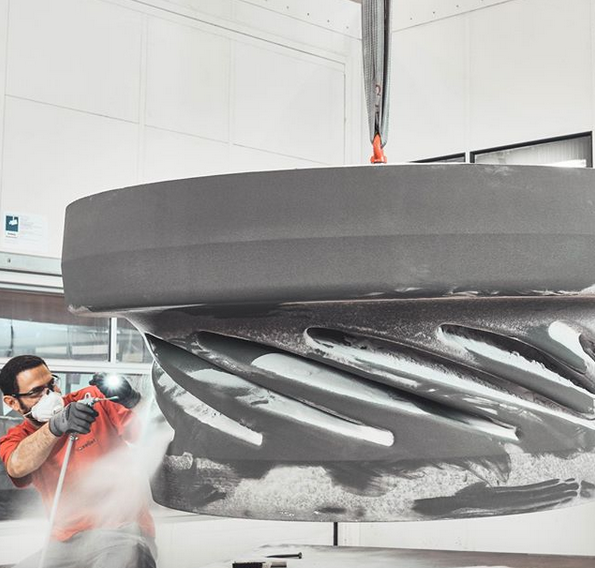After markets closed on August 12, 2021, voxeljet (Nasdaq: VJET) posted its latest quarter results, which show a substantial improvement from the first quarter of the year as 3D printing is picking up. As a result, the manufacturer of high-speed, large-format 3D printers and on-demand parts services reported better-than-expected revenues and issued earnings losses of €2.5 million ($3 million) or €0.41 ($0.48) per share for the second quarter of 2021, a 51% improvement compared to the same period in 2020.
The German-headquartered firm also posted strong revenue growth with a 26.2% increase year-over-year, from €3.9 million ($4.6 million) to €4.9 million ($5.8 million) as an increasing number of companies are realizing the opportunities of industrial 3D printing. Most of this growth comes from the systems segment, which focuses on the development, production, and sale of 3D printers, and represented roughly 54% of the total revenues of the quarter, compared to 47.8% in last year’s second quarter.
Revenue from the sale of 3D printers, consumables, spare parts, maintenance contracts, upgrades, and other after-sales activities increased. As a result, the segment underwent a year-on-year increase of 42.9%, from €1.9 million ($2.2 million) in last year’s second quarter to €2.7 million ($3.2 million). During this time, voxeljet sold larger scale platforms compared to last year’s same period, reflecting a recovery from the economic slowdown that resulted from the ongoing global Covid-19 pandemic.
However, the systems segment provided slightly lower gross profit margins than voxeljet’s services business, which increased significantly during the quarter ending June 2021, driven mainly by continued strong performance in the German 3D printing center, which reported a gross profit margin of around 40%.
Additionally, the company announced that the contribution from its facilities in the United States and China have improved as utilization is picking up, especially in the U.S., which has reported a strong order inflow for on-demand printed products during the second week of August, before the release of the Q2 earnings report. For this segment, revenues increased 11% to €2.3 million ($2.7 million) from €2 million ($2.4 million) in 2020.
Management historically self-describes voxeljet as a backend loaded business, which is why voxeljet Co-Founder and CEO Ingo Ederer said the majority of 3D printer sales is recognized in the second half and the fourth quarter of the year. He expects 2021 to be no different. During a call with investors on August 13, 2021, Ederer explained that the company currently ships between 20 and 25 printers on a yearly basis, at an average price in the range of $500,000 and $700,000 per system. However, he also asserted that the company wants to grow this number over the next few years.
As for the remaining months of the 2021 fiscal year, the executive said he expects the revenue for the third quarter to be between €4.5 million ($5.3 million) and €5.5 million ($6.5 million). Looking ahead to the full year 2021, voxeljet plans to drive revenue in the range of €22.5 million ($26.5 million) and €27.5 million ($32.4 million). If his guidance is correct, this would be upbeat compared to revenues for 2020, which were at €21.6 million ($25.4 million), and closer to 2019 revenues, then at €24.6 million ($29 million).
While trying to leave behind some of the uncertainties caused by the pandemic, Ederer saw significant progress in key projects, including a recently signed deal with a large multinational corporation for the new High-Speed Sintering 3D printer as part of voxeljet’s beta program launched early in 2021. Over the last months, voxeljet significantly improved the stability and reliability of the new 3D printer and is currently in the process of ordering parts for the assembly of the first unit. Additionally, the company said it successfully shipped VJET X units to a premium German carmaker, which have been installed in parallel with the ongoing operation of the VJET X units already in production.

With an overall build space volume of 4x2x1 meters, the VX4000 is the largest industrial printer in the world. Image courtesy of voxeljet.
Voxeljet has also established relationships with blue-chip customers from various industries, including space companies. For example, it recently received a large repeat order from a leading U.S. space exploration company for printed acrylic patterns to cast external parts.
Although the risks and uncertainties resulting from the ongoing Covid-19 pandemic are still lingering throughout the global economy, the 3D printing industry seems to be recuperating its momentum. In fact, the binder jetting market, in particular, is still agitated following the acquisition of ExOne by Desktop Metal in a deal valued at $575 million.
As one of the key players in the binder jetting market and with more than 20 years in the market, voxeljet remains one of the pioneering companies in the industry. However, as the playing field for mergers and acquisitions intensifies, we can’t help but wonder whether voxeljet will be the next ExOne, or if it will continue navigating by itself in an industry where collaborations, partnerships, and deals thrive.
Subscribe to Our Email Newsletter
Stay up-to-date on all the latest news from the 3D printing industry and receive information and offers from third party vendors.
You May Also Like
Precision at the Microscale: UK Researchers Advance Medical Devices with BMF’s 3D Printing Tech
University of Nottingham researchers are using Boston Micro Fabrication‘s (BMF) 3D printing technology to develop medical devices that improve compatibility with human tissue. Funded by a UK grant, this project...
3D Printing Webinar and Event Roundup: April 21, 2024
It’s another busy week of webinars and events, starting with Hannover Messe in Germany and continuing with Metalcasting Congress, Chinaplas, TechBlick’s Innovation Festival, and more. Stratasys continues its advanced training...
3D Printing Webinar and Event Roundup: March 17, 2024
It’s another busy week of webinars and events, including SALMED 2024 and AM Forum in Berlin. Stratasys continues its in-person training and is offering two webinars, ASTM is holding a...
3D Printed Micro Antenna is 15% Smaller and 6X Lighter
Horizon Microtechnologies has achieved success in creating a high-frequency D-Band horn antenna through micro 3D printing. However, this achievement did not rely solely on 3D printing; it involved a combination...































